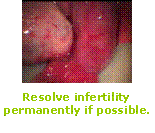
|
distal tubal disease and selection for surgery can be difficult. Often damage varies from one side to the other, and in this heterogeneous group of patients the outcome can be unpredictable.
CORNUAL BLOCK
Tubal block at the cornua can be as a result of infection, sterilisation or endometriosis. Ehrler and Green Armitage in 1965, described their technique of tubal implantation and demonstrated that in most of the patients the intramural portion of the tube can be spared. Winston and Gomel described their anastomotic techniques based on the use if the microscope. Cornual anastomosis has the advantage of maintaining tubal length, integrity of the cornua and offers higher pregnancy rates. The technique of cornual anastomosis includes the identification of the intramural portion of the tube by careful shaving of the cornua and then joining healthy isthmus or ampulla directly to the intact intramural portion of the tube. The best method for exploring the cornua in order to identify healthy tubal lemen has been described by Winston and by McComb. More than 50% of patients conceive after superficial cornual anastomosis .
The results of reversal of sterilisation are in general better than those achieved after inflammatory damage. Tubal damage is more limited and most of the patients who request reversal procedures are very fertile. Isthmo-isthmic anastomosis gives the best results and ampullo-ampullary anastomosis is less satifactory. This may be related to the physiological importance that the damage at this level may interferer with ovum retrieval by the fimbria, fertilisation or gamete transport. The total length of the residual tube is a very important factor. The minimum length of tube to maintain fertility in women is not known. Women with short tubes only occasionally conceive and patients with a short ampulla less fertile. When the fimbria are missing the results are very poor in the hands of most surgeons.
|


